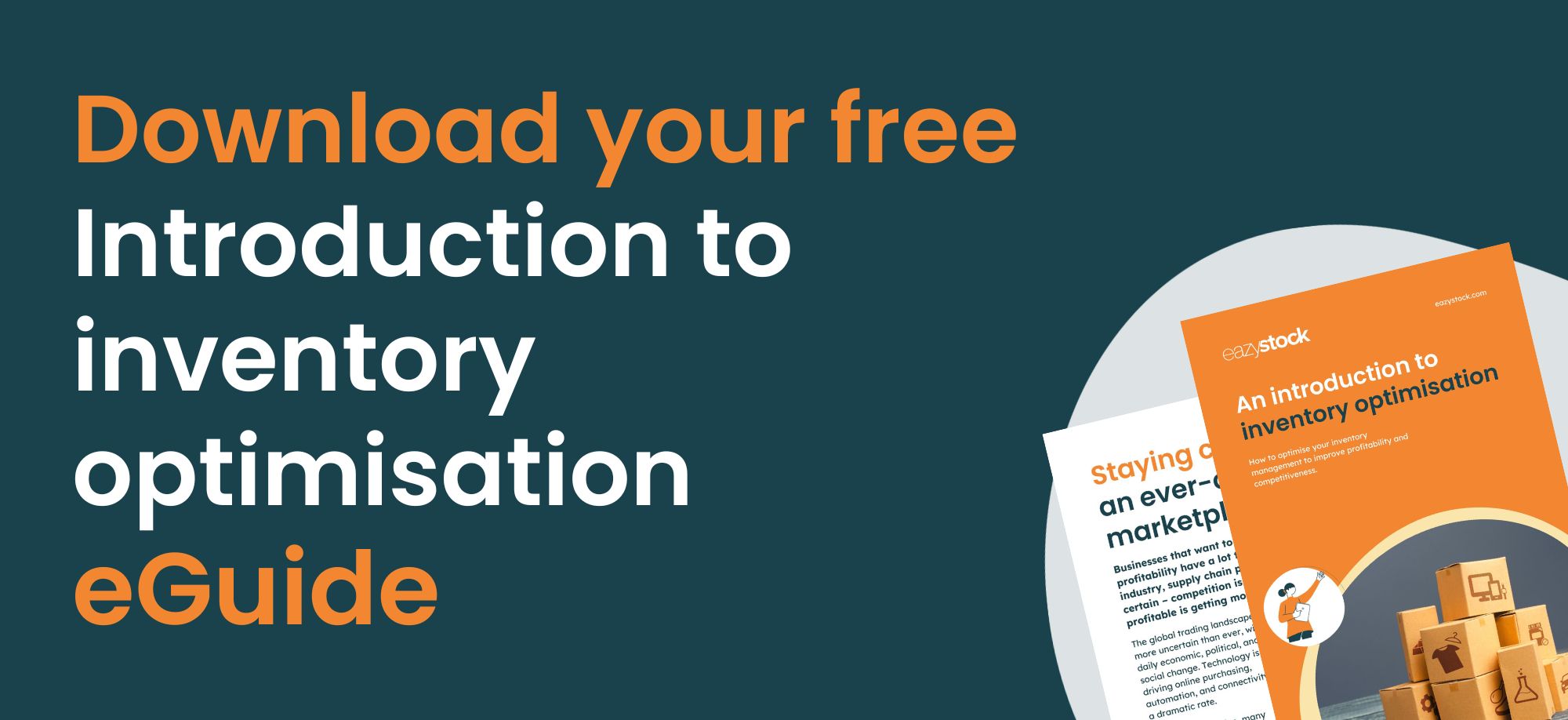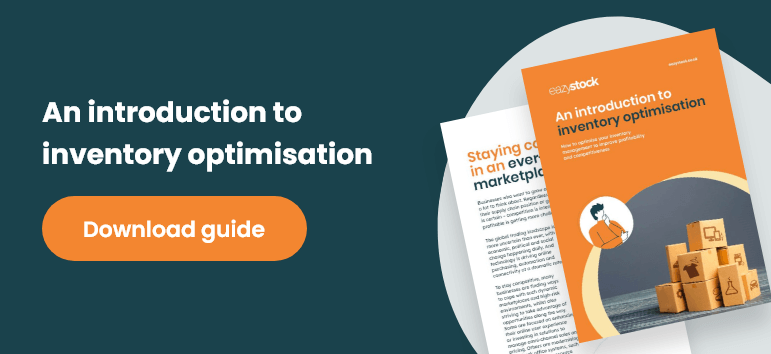What is service level in inventory management (Guide)
For many years, inventory-holding businesses have used stock days in their inventory management calculations to determine whether they have the right amount of stock to fulfil orders. In this blog post, we’ll explain why this methodology is unsuitable for today’s trading environment and introduce service levels as a more effective way to manage inventory.
Stock days – a definition
Stock days is a well-known inventory KPI, also called Days in Inventory, Days Sales in Inventory, or Days Inventory Outstanding. It is a ratio that measures the average number of days that stock is held before being sold, e.g., the time it takes for the goods to sell.

The stock days formula is calculated by inverting the inventory turnover ratio and multiplying it by 365, to put the figure into a daily context.
Stock days and managing inventory
Stock days are the output of many common calculations used in inventory management. For example, a simple reorder point formula calculates the number of stock days needed to satisfy demand during a lead time. While a basic safety stock formula provides a specific number of stock days that should help cover unforeseen fluctuations in demand and lead times.
In summary, when inventory management teams talk about stock days, they’re usually trying to work out how to:
- Calculate how much stock to order to fulfil demand
- Improve order fulfilment
- Reduce capital tied up in inventory
- Improve inventory turnover
- Lower carrying costs
- Prevent stockouts caused by erratic demand and inconsistent lead times
However, there are a number of essential reasons why focusing on stock days is a bad idea when you’re trying to overcome these inventory management challenges:
Linear calculations that utilise stock days cannot account for supply and demand volatility
Firstly, whenever you use stock days in an inventory management calculation, such as to determine how much or when to reorder, the results are always going to be flawed. This is because stock days formulas are linear and almost always based on average consumption and static lead times. While this makes them easy to calculate, they can’t account for supply and demand volatility and this often leads to inaccurate results.
With consumer demand and supply chains worldwide greatly impacted by political, economic, social, and environmental factors, it’s more critical than ever to start using calculations and KPIs that can account for variance.
Let’s take a common reorder point formula as an example:
A key flaw with the reorder point formula is that it relies on the supply and demand elements being constant and, in ‘real-life’, this is rarely the case!
For starters, using average historical consumption to calculate upcoming lead time demand is only a good idea if your item has flat, consistent demand, e.g. you sell the same amount of the item during every order cycle. If the item’s demand is impacted by seasonality or market trends, then previous consumption isn’t an accurate reflection of future demand. In reality, the demand for most items will fluctuate, and unless this is taken into account, then you’re going to suffer from either stockouts or excess inventory.
The same is true of lead times. As many businesses have experienced in recent years, lead times can be severely impacted by anything from a simple national holiday to bad weather conditions, customs issues, and even global pandemics. Yet linear stock day calculations do not have the ability to take these into account. As erratic lead times seem set to stay, unless you have the time to regularly refresh your calculations with updated lead times, you’ll face dealing with the consequences of inaccurate results.
Focusing on stock days will not optimise inventory levels
A common conundrum for many businesses is how to optimise stock levels, e.g. reduce inventory investment without harming order fulfilment. This objective involves balancing the cost of buying and holding stock, with the ability to satisfy demand. If you decide to adjust one side of the scales you need to understand the impact on the other.
Whilst the stock days formula is a good way to understand how quickly stock is turned, it’s an inadequate metric for accounting purposes to use to optimise inventory.
This is because stock days are disconnected from the customer experience. For example, if you decide to reduce your number of stock days to lower carrying costs, how do you know how this will affect stock availability and what impact this will have on customer service?
In a world where customer satisfaction is at the heart of many business’s success, inventory management metrics need to be able to relate back to this key KPI.
This is why more and more inventory management teams are ditching linear stock days calculations and, instead, focusing on service levels.
Introducing service levels
We’ve already discussed the need to account for supply and demand variance when managing stock and that simple inventory management techniques cannot do this. To take variance into account, you need to use formulas that measure risk, and the best way to do this is to use probabilistic formulas.
A probabilistic approach accepts that predicting future events is uncertain and accommodates this by covering a percentage of all possible inventory requirements. This is where service levels come in.
Service levels in inventory management
In inventory management, service level is the expected probability of satisfying all possible inventory requirements within a particular period of time. For example, if you set a service level target of 99%, this means your safety stock levels will cover 99% of all probable requests; in other words, you can give your customers what they want when they want it, 99% of the time.
Your service level is important as it’s linked to how well you can serve your customers with on-time deliveries. Any out-of-stock item, even if it’s just one SKU, will lead to an incomplete order which can be detrimental to customer satisfaction. The service level KPI, therefore, closely correlates with customer service, acquisition, loyalty and retention.
How to determine service levels for inventory items
Service level targets are usually set specific to each individual inventory item or SKU. Carrying high levels of stock across all SKUs is expensive, so often inventory classification is used so different availability targets can be determined across your product portfolio.
The simplest way to do this is to use ABC inventory analysis, where the items that generate the most revenue are set to the highest service levels. More complex inventory classification models can also be used, which group items based on demand volatility, pick frequency, profit, or the value of annual usage. The result is that you can adjust service levels so they’re higher for items that are cheaper to stock and have steady demand, while they’re lower for those that are more expensive and sell less frequently.
With your service levels set and continuously measured, you can then make inventory decisions and set stock levels, reorder points, safety stock levels, etc, based on the level of stockout risk you’re willing to take for each category.
The role of automation
Moving from inventory management processes that focus on stock days to inventory optimisation processes that focus on service levels requires a good knowledge of statistical mathematics, as there are many probabilistic formulas involved. This is why many businesses are connecting technology, in the form of inventory optimisation software, to their ERPs to do the calculations for them.
Automation enables sophisticated analysis and management of thousands of inventory items. It makes it possible to drill down into individual SKUs so you can act when there’s a risk of over or under-stocking.
Software, such as EazyStock, automatically classifies every inventory item based on a selection of advanced algorithms and sets relevant service levels. It then automatically forecasts demand and adjusts reordering parameters, such as safety stock levels and reordering quantities, to ensure the targets are met. It can also account for supply variance in terms of fluctuating lead times and ordering constraints, e.g., min/max order quantities, etc.
Summary: start measuring service levels – not stock days!
If your business is serious about putting customers at the heart of your operations, whilst also looking to maximise inventory investment, you should ditch stock days as an inventory management metric. And, with supply chains more dynamic than ever, it’s critical that you manage stock with supply and demand variance at the heart of every calculation.
The answer is to focus on service levels and introduce sophisticated probabilistic formulas, using an inventory optimisation tool to support them. As a result, you’ll be able to utilise advanced algorithms for inventory forecasting, planning, and replenishment that could never be possible in Excel spreadsheets. Stock levels will be optimised, and stock availability will match customer demand. At the same time, you’ll be more efficient and free up your schedule to focus on suppliers and customer management.











